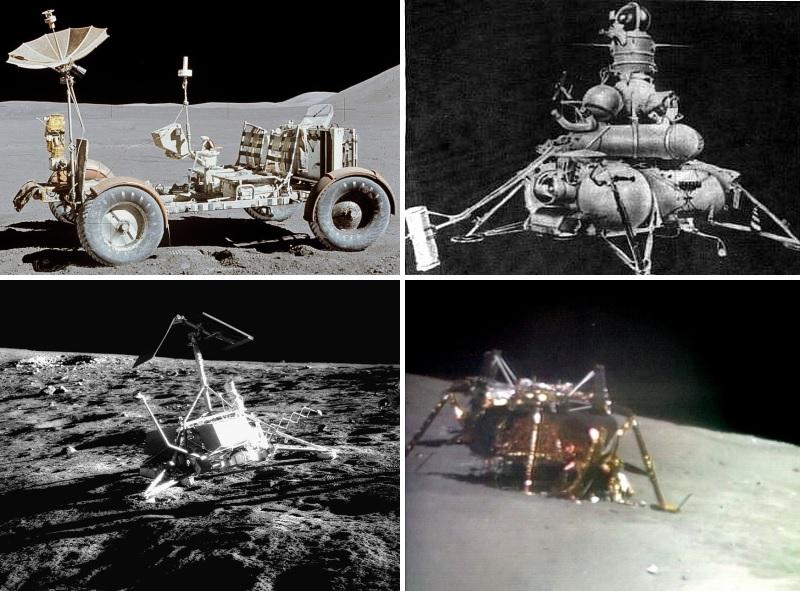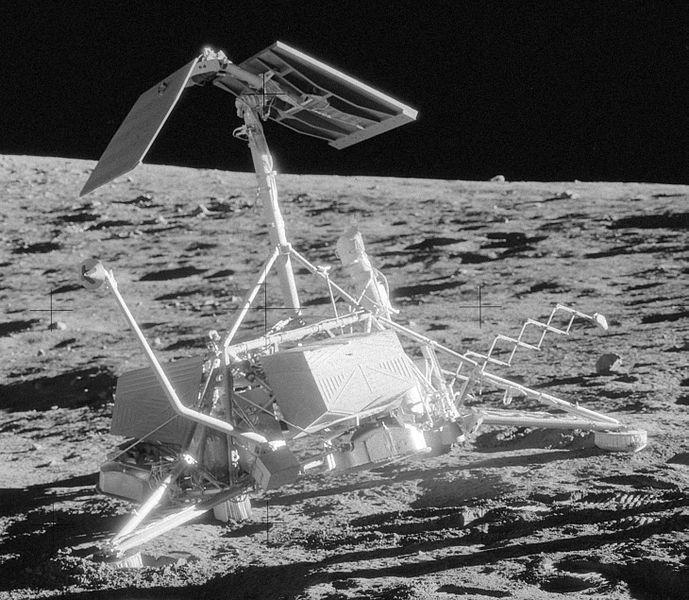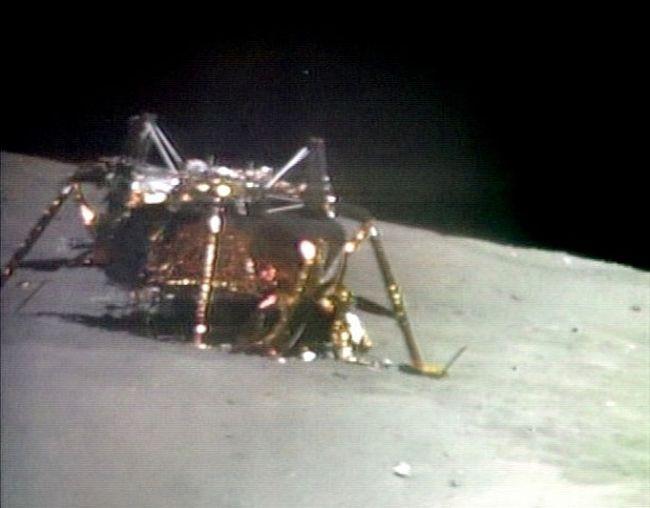
In the whole of human history, only a handful of people have ever set foot on a celestial body that wasn’t our own. There were 12 in total, all were male, and all were American. The distant object they visited? The Moon.
Our loyal grey satellite has had an incomparable effect on human history. Its gravitational pull is why we have tides. Oracles have made predictions by it, rituals have been tied to it, and wars lost and won on the basis of this distant chunk of rock. Yet, important as the Moon is, it is also the least-visited of all places we humans have ever trod. Nobody has been there since 1972. There are currently plans to put humans on Mars, but none to return to the Moon.
Yet our few, fleeting visits have still left an impact on this distant world. Scattered across a small number of landing sites are the abandoned spacecraft and vehicles of our lunar expeditions; remnants of a great, past epoch of space exploration.
Surveyor 3 (Abandoned Lunar Lander)
 (Image: NASA; abandoned lunar lander Surveyor 3 spacecraft)
(Image: NASA; abandoned lunar lander Surveyor 3 spacecraft)
It often gets scrubbed from the history books now, but before Neil Armstrong and Buzz Aldrin set foot on the Moon, there were a flurry of probes and robots hurled at the lunar surface by both the USA and USSR. In 1966, the Russians placed a robot lander there. A year later, the Americans responded with Surveyor 3.
A man-sized collection of wires and antennae, Surveyor 3 today looks unbelievably primitive. Yet its mission was a great success. After touching down in the vast Ocean of Storms, it managed to beam back over 6,300 lunar images.
Despite its achievements, Surveyor 3 only had the shortest of lives as a functioning scientific instrument. When lunar nightfall occurred less than two weeks after landing, the probe shut down and froze solid, never to work again. Interestingly, though, this wasn’t the last time the abandoned spacecraft would appear in an official NASA capacity. A few years later, the crew of Apollo 12 visited the site, taking a picture of the now defunct Surveyor.
Apollo 15 Abandoned Moon Buggy (Lunar Roving Vehicle)
 (Image: NASA; abandoned Lunar Roving Vehicle from Apollo 15)
(Image: NASA; abandoned Lunar Roving Vehicle from Apollo 15)
Like the Space Shuttle, the moon buggy is arguably one of the most iconic pieces of kit in the history of space exploration. Grainy 1970s footage of astronauts bouncing over the dusty lunar surface is imprinted onto the minds of nearly everyone on Earth. Used in the Apollo 15, 16, and 17 programs, the Lunar Roving Vehicle (LRV) was battery powered and assembled on-site. This convenience also made it hard to bring back. Currently, three abandoned moon buggies remain stranded on our satellite.
Of all of these, the Apollo 15 LRV is undoubtedly the most iconic. The first to be deployed, in 1971, it captured the imagination of a whole generation. Its final resting place is no less romantic. Parked up on the eastern edge of the Sea of Rains, in the middle of the Marsh of Decay, it now waits out the rest of eternity in the shadow of great mountains, alternately scorched by the sun and frozen by the lunar night.
Luna 20 Abandoned Spacecraft

 (Images: NASA; Luna 20 abandoned spacecraft location)
(Images: NASA; Luna 20 abandoned spacecraft location)
The remains of the abandoned Luna 20 are a good reminder that it wasn’t only the USA and NASA that helped mankind understand the Moon. Up until 1980, the USSR was equally-interested in the lunar surface, dispatching probes, and forever planning a manned follow-up mission. While the latter clearly didn’t materialize, the probes certainly did, many of which still remain in some form or other on the Moon. Chief among these was the Luna 20.
A sample-gathering spacecraft, Luna 20 was designed to survive long enough to scoop up some Moon soil, blast it back into space, and then shut down permanently. To the Soviets’ credit, that’s exactly what it achieved. Shortly after touchdown, Luna 20 blasted itself back up above the Moon, then fired its sample capsule at Earth, eventually hitting a small island in Kazakhstan (then part of the Soviet Union). The original probe then tumbled back down, crashing onto the dusty lunar surface. In 2010, a NASA Lunar Orbiter flyby managed to snap the picture you see above, the first anyone had seen of the abandoned Luna 20 spacecraft in nearly 40 years.
Apollo 16 Lunar Module (Orion) Descent Stage
 (Image: NASA via Astronotes; Orion Lunar Module derelict descent phase)
(Image: NASA via Astronotes; Orion Lunar Module derelict descent phase)
The penultimate manned mission to the Moon (to date, at least), Apollo 16 is now imbued with a heavy historical significance. At the time, though, that was not the case. NASA was already planning an Apollo 18, and there was no reason for anyone to suspect the upcoming Apollo 17 would be the last. Perhaps that explains the lack of ceremony in the abandoning of the Orion.
The descent stage module for the Apollo 16 landing, the Orion looked like nothing so much as a giant mechanical spider. Yet it was essential for the survival of the mission; the place where the three-man crew stowed critical scientific equipment, which also served as a launch pad to blast the astronauts away from the lunar surface in the ascent stage.
Today, the Orion lunar module sits in an anonymous stretch of wasteland, far from anywhere. Sheltered from the effects of weathering, it is likely to last even longer than the pyramids down on Earth. In other words, it may turn out to be one of humankind’s most lasting legacies.
Apollo 17 LRV & LM Challenger Descent Stage
 (Image: NASA; Apollo 17 abandoned moon buggy and (behind) the Lunar Module)
(Image: NASA; Apollo 17 abandoned moon buggy and (behind) the Lunar Module)
Everything associated with Apollo 17 today comes with a tinge of melancholy. This was it: the last time humans boldly went where Neil Armstrong had taken that first giant leap for mankind. While Elon Musk’s Space X has hopes to place a human on Mars by 2026, and NASA is devising its own mission for the early 2030s, Apollo 17 to date remains the last time we flirted with being an off-world species. That it took place nearly 45 years ago seems incredible.
As a result, the sight of the old Lunar Roving Vehicle, and the Lunar Module, sitting quietly on the distant Moon, is one that’s both quietly momentous and faintly sad. Perhaps the worst part is that it didn’t have to be this way. After the 1969 moon landing, NASA had already built the spacecraft for and commissioned Apollos 18, 19, and 20. Landing sites had been chosen. Crew selected. And then Nixon slashed NASA’s budget to the bone. The American public lost interest, and saving a paltry $42 million was considered a price worth paying for halting the program.
 (Image: NASA; location of Apollo 17’s abandoned Challenger descent phase)
(Image: NASA; location of Apollo 17’s abandoned Challenger descent phase)
Perhaps the greatest irony is the plaque the two Apollo 17 astronauts, Eugene Cernan and Harrison Schmitt, left behind. Part of it read: “Here Man completed his first explorations of the moon.” Little did they know it would also be his last.
Related: Graveyard Orbits: The Strange Afterlife of Space Junk and Dead Satellites
The post 5 Abandoned Spacecraft & Vehicles Resting on the Moon appeared first on Urban Ghosts Media.